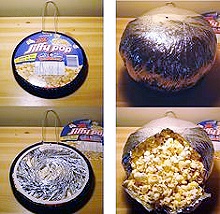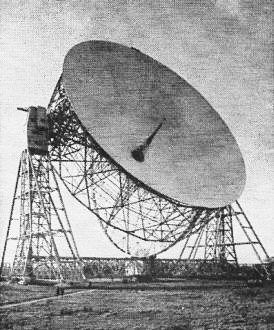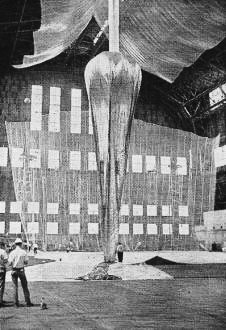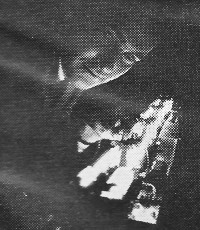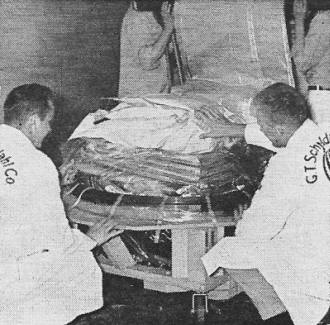Stage Set for U.S. - Soviet Space Tests
|
|
The Jiffy Pop Popcorn (1959) company might have had a valid case for patent infringement against NASA for using the concept on ECHO satellites ;-) A love-hate relationship between major nations competing for leadership and dominance in the military and aerospace technology realms has existed in earnest at least since the space race began. Often, the pilots, astronauts, scientists and engineers are much more willing to set aside political differences in order to more effectively and efficiently advance the state of the art and/or basic knowledge. Maybe archeologists, biologists, endocrinologists, climatologists, zoologists, pathologists, and you-name-it-ologists feel the same way, but those types, dealing with squishy living things, are probably more altruistic than your typical physical sciences guy (or gal). It is the government management sides of the equation agonizing over the need to solicit or accept foreign assistance. There is (or was at the time) no better example than the U.S.A. (United States of America) and the U.S.S.R. (Union of Soviet Socialist Republics), particularly for space-based communications. Satellites were a very new entry into the radio world and both sides needed each other's help in testing and assessing the few "birds" being launched. In particular, high gain earth-based receiver systems were required to track and monitor signals, and being a fledgling science, there were not very many to choose from across the globe. Beginning with Sputnik, even Ham radio operators sent reports of signal strength and time-in-view to Moscow and in return often were rewarded with official Sputnik QSL cards. Stage Set for U.S. - Soviet Space TestsU.S., Russians and English ready tests, stations for Echo II satellite By Joel A. Strasser Assistant Editor A - Jodrell Bank station will link U. S. with USSR via satellite to Zimenki Observatory at Gorki State University. Launch of Echo II, scheduled for January 23 aboard a Thor-Agena B from the Pacific Missile Range will, if successful, set the stage for Soviet participation in U. S. space activities. Under terms of the recent U. S.-USSR cooperative agreement concerning Echo II, experiments will be conducted between the Jodrell Bank station in Cheshire, England and Russia's Zimenki Observatory at the Gorki State University. Signals will be carried from the U. S. to England using conventional facilities, and then bounced to the satellite from Jodrell Bank for relay to Russia. Soviet experiments with the passive communications satellite balloon are expected to be limited to receiving signals only, Sir Bernard Lovell, director of England's Jodrell Bank Experimental Station told ELECTRONICS. Leonard Jaffe, NASA's director of communications systems, however, told ELECTRONICS that he feels the Russians will want to transmit back to Jodrell Bank at 162 Mc, and would be agreeable to expanding the tests to include experiments in the microwave frequencies. If the Russians are agreeable to this expansion, the U. S. would rely on the 10 kW transmitter at Goonhilly Downs to send signals to Russia at 1,725 Mc, Donald P. Rogers, Echo II project director at NASA headquarters, told ELECTRONICS. Rogers indicated that while it would be technically feasible for the Russians to respond at 4,170 or 4,080 Mc, Jodrell Bank would not be used for microwave tests since the station loses efficiency above 500 Mc. U. S.-Soviet Test Details - Present plans call for Jodrell Bank to transmit at 162.4 Mc, using their Mark I, 250-ft-aperture radio telescope. The power gain of the British telescope at that frequency is 40 db, according to Lovell, who plans to use a 1 kw c-w transmitter with circular polarization. Gorki station in the USSR will receive the signals from Jodrell Bank using a radiotelescope that measures 45 ft in diameter with a gain of about 25 db at 162.4 Mc. Distance between Gorki and Jodrell Bank is 1,850 miles and assuming Echo II to be at an altitude of 700 miles, the distance of each station to the satellite is 1,200 miles. Using these figures as a basis for calculations, Lovell has listed the following signal-to-noise ratios expected at the Gorki station from the Jodrell Bank transmissions: • Unmodulated carrier, 17.7 db • A-m to a depth of 50 percent by a 400-cps tone, 11.7 db • A-m by speech, 2.3 db •Time expanded speech, at 2:1 ratio, 5.3 db; at 4:1 ratio, 8.3 db; at 8:1 ratio, 11.3 db; at 16:1 ratio, 14.3 db • Telegraphy, 20.7 db • Facsimile (peak signal/mean noise), 17.7 db Gorki Station-Zimenki Radio-Astronomical Observatory, sponsored by the Gorki Physiotechnical Research Institute, is located at 57 deg, 22 min north, 45 deg, 3 min east - about 200 miles northeast of Moscow. The observatory has been used principally for measurements of solar radiation and the intensity of radio emission of the sun and some discrete sources. One reference lists the station as having a 20-ft dish and two 50-ft dishes, one of the latter probably slated for the Echo tests. Station frequencies are 75, 200, 3,000 and 9,400 Mc. In 1947, a modulated radiotelescope was built at Gorki to measure solar radiation at 75 Mc. Microwave equipment for operation at 3,000 Mc was also constructed that year but not used immediately. The following year a 200 Mc radiotelescope was built, where modulation was achieved by rocking the scan pattern of the antenna to diminish the effects of galactic background radio emission and undirected noise . It started operating in 1949, according to a GE source.
Twin-Tube Laser With the 3,000 Mc radiotelescope built in 1950, data was collected on the relationship between the intensity of radio emission and sun spots. Modulation was achieved by rotating an offset dipole of the receiving antenna. In 1952, a new 3,000 Mc telescope was built that permitted use of the null method of measurement, as well as rapid thermal calibrations. By 1950, Zimenki was observing radio emissions of the sun at 9,400 Mc with apparatus similar to a Dicke radiometer. Antennas - Information from various sources indicates that Zimenki has used numerous antennas for different purposes. Apart from the antenna configurations listed above, Philco advises that the station has three dishes. A 13.1 ft steerable parabolic antenna at the station reportedly operates at 9,400 Mc, 328 Mc and in the millimeter wavelengths. The company also reports 50- and 19.7-ft steerable parabolic dishes. The International Union Committee on Frequency Allocation and Space Sciences, in a report or frequencies assigned by the Geneva regulations of 1959, mentions a 16.4-ft dish operating at 2,690 to 2,700 Mc and an antenna array measuring 49.2 by 33 feet that operates from 150 to 153 Mc.
Posted April 15, 2024 |
|

